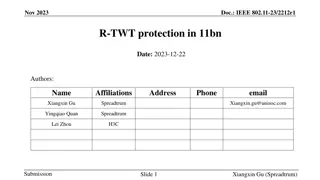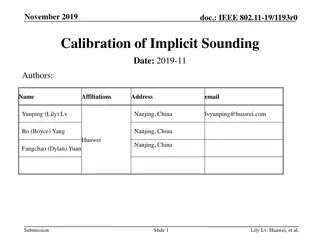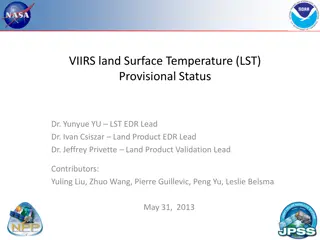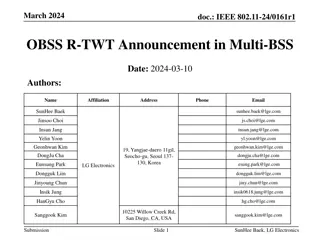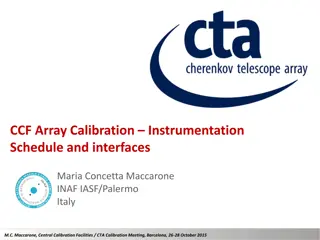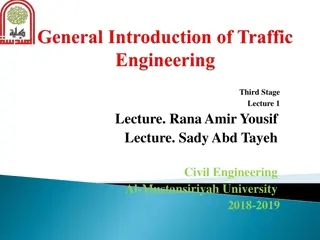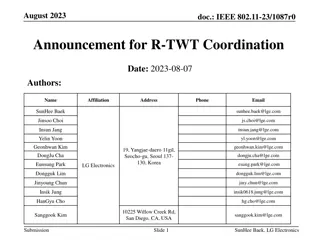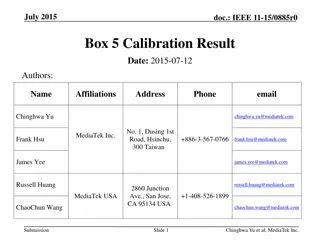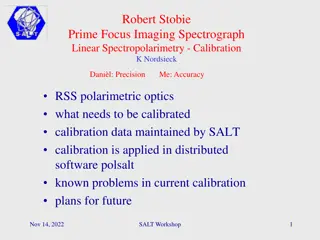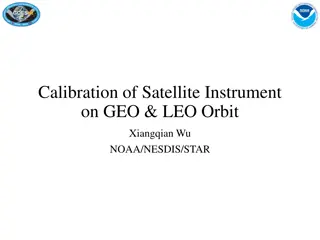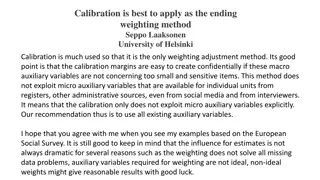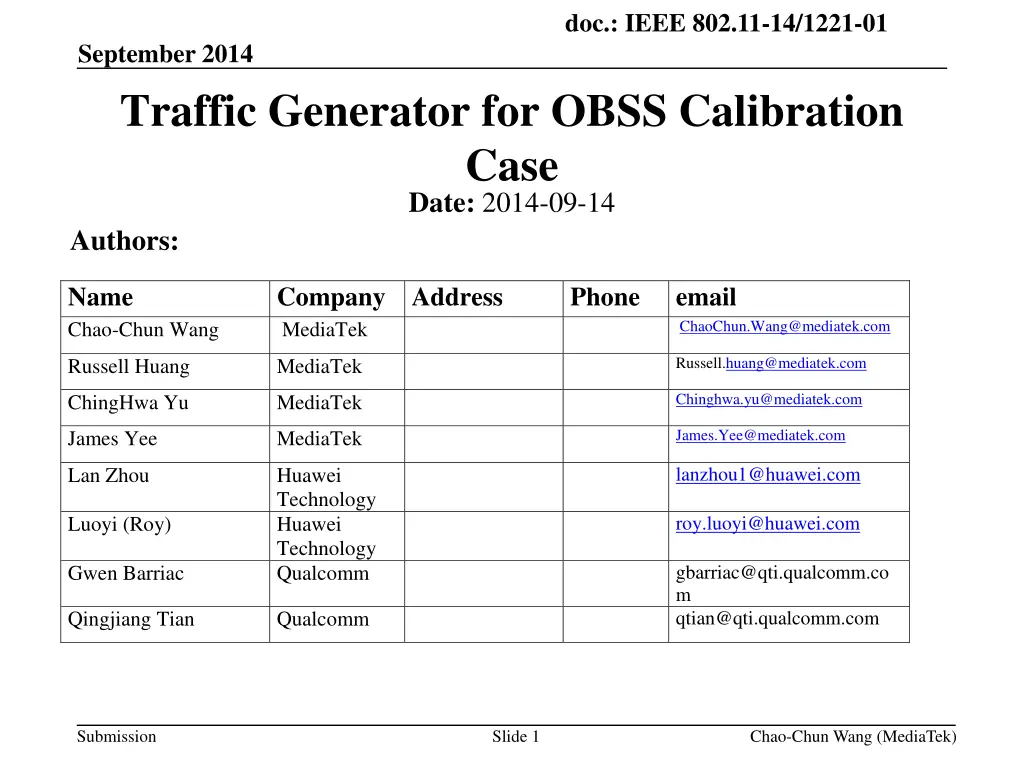
Traffic Generator for OBSS Calibration Case Analysis
"Explore the implementation of Poisson distribution as an alternative to Weibull for generating traffic in the context of MAC calibration for OBSS scenarios. Understand the differences, challenges, and advantages between the two distribution models for efficient traffic generation."
Download Presentation

Please find below an Image/Link to download the presentation.
The content on the website is provided AS IS for your information and personal use only. It may not be sold, licensed, or shared on other websites without obtaining consent from the author. If you encounter any issues during the download, it is possible that the publisher has removed the file from their server.
You are allowed to download the files provided on this website for personal or commercial use, subject to the condition that they are used lawfully. All files are the property of their respective owners.
The content on the website is provided AS IS for your information and personal use only. It may not be sold, licensed, or shared on other websites without obtaining consent from the author.
E N D
Presentation Transcript
doc.: IEEE 802.11-14/1221-01 September 2014 Traffic Generator for OBSS Calibration Case Date: 2014-09-14 Authors: Name Chao-Chun Wang Company Address MediaTek Phone email ChaoChun.Wang@mediatek.com Russell.huang@mediatek.com Russell Huang MediaTek Chinghwa.yu@mediatek.com ChingHwa Yu MediaTek James.Yee@mediatek.com lanzhou1@huawei.com roy.luoyi@huawei.com James Yee MediaTek Lan Zhou Huawei Technology Huawei Technology Qualcomm Luoyi (Roy) gbarriac@qti.qualcomm.co m qtian@qti.qualcomm.com Gwen Barriac Qingjiang Tian Qualcomm Submission Slide 1 Chao-Chun Wang (MediaTek)
doc.: IEEE 802.11-14/1221-01 September 2014 Summary MAC calibration for OBSS scenario was presented in July IEEE meeting 11-14-0895-01-00ax-mac-calibration-obss-scenerio 11-14-0972-01-00ax-mac-calibration-test-case-for-20-40-mhz-channel The proposal was accepted and included in the 11-14-0980-02-00ax-simulation-scenarios The traffic generator for the 20MHz BSS traffic is based on the Weibull distribution 2Mbps traffic, lamda = 695, k=0.8099 The concern is Weibull is too complicate to implement for the calibration scenario Proposed to replace Weibull distribution with Poisson traffic distribution in the traffic generator Submission Slide 2 Chao-Chun Wang (MediaTek)
doc.: IEEE 802.11-14/1221-01 September 2014 Weibull vs. Poisson Weibull Traffic is generated in a fixed interval The frame size varies based on video frame rate. Poisson The inter-arrival time of frames is exponentially distributed with parameter lambda The frame size and the number of frame are fixed, for example one fixed size frame. Poisson is more predictable and easier to implement Submission Slide 3 Chao-Chun Wang (MediaTek)
doc.: IEEE 802.11-14/1221-01 September 2014 Traffic Generator with Poisson Distribution How to generate traffic with Poisson distribution MSDU length at 2000Bytes. Let lambda, for example, to be 100 ( in the unit of 1/second) The mean inter-arrival time is 1/100 second. The long time average data rate for the largest MSDU size is 2000*8/(1/100)=1.6Mbps 1.6 Mbps is non-full buffer traffic since it is lower than the 20MHz BSS MCS0 rate Submission Slide 4 Chao-Chun Wang (MediaTek)
doc.: IEEE 802.11-14/1221-01 September 2014 Implementing Traffic Generator Vendor specific implementation A Poisson distribution traffic generator For NS -3 Using On-off traffic generator On period: constant, say T_on send 1 packet The sum of on period is added to the simulation time Off time: Generating an exponentially distributed waiting time, say T_Total T_off = T_total-T_on Submission Slide 5 Chao-Chun Wang (MediaTek)
doc.: IEEE 802.11-14/1221-01 September 2014 Stability of the Average How long should be the simulation time? Lambda is the mean of inter-arrival time How long it will take for the mean to be stabilized How to determine the simulation time Each simulator calibrates its running time Step 1: Activate 20MHz BSS only and monitor how long it will take for the throughput of the 20MHz BSS to be stabilized. The throughput of the 20MHz BSS shall corresponding to the mean inter arrival time and record the time, t. Step 2: Run the OBSS MAC calibration case for at least time t. Submission Slide 6 Chao-Chun Wang (MediaTek)
doc.: IEEE 802.11-14/1221-01 September 2014 Straw Poll Do you agree to revise the traffic generator to use Poisson traffic generator? Y N Abs Submission Slide 7 Chao-Chun Wang (MediaTek)
doc.: IEEE 802.11-14/1221-01 September 2014 Back Up Submission Slide 8 Chao-Chun Wang (MediaTek)
doc.: IEEE 802.11-14/1221-01 September 2014 Deferral test for network of different channel bandwidth The set up and configuration is the same as test case 2a If packets collide, the both transmission fail The first BSS operates in 40 MHz channel The second BSS operates in a 20MHz channel which is the secondary channel of the first BSS With no channel model, the collision detection is determined by time domain information Any overlapping MPDU is considered a failure The secondary channel is consider free if there is no transmission on the secondary channel for PIFS The 40MHz BSS is running full buffer. The 20MHz BSS traffic is based on the Weibull distribution 2Mbps traffic, lamda = 695, k=0.8099 The results other than throughput and PER of each BSS also include The percentage of time the 40MHz BSS running in 40 and 20 MHz mode. AP1 AP2 BSS_1 BSS_2 Slide 9 STA2 STA1 Submission Chao-Chun Wang (MediaTek)


